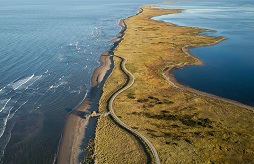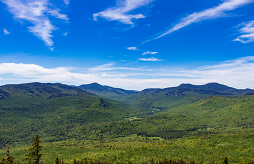.jpg)
Fishing for Answers on the Miramichi
A fishing way of life on the Miramichi River – and how changes in Atlantic Salmon populations are being addressed.
Life on the Miramichi
For Debbie Norton, the Miramichi is synonymous with fishing and Atlantic Salmon.
From the time she was two years old, she was following her father around fishing. She recalls her father heading down to the river every day and coming back with a fish for their meal.
Like so many of her family before her, Debbie Norton was born on the river. Her family has lived on the Miramichi for over 200 years.
“[My father] was a great angler and he taught me to love to fish and how to fish, and I loved the whole experience of being out and angling with him,” Debbie says, “Certainly my love of the outdoors and my times that I spent learning how to fish and being around the river with my dad would translate into what I’m doing now.”
.jpg) |
| Debbie (centre), pictured here with her brother and cousin, holding a fish caught by her father. |
Now, Debbie shares her passion for the river and for fishing through her work as an outfitter on the Little Southwest of the Miramichi River. One part of what she does is help others learn about the river and the fish that live in it.
“We work really hard at passing our passion on to all of our guests who come in – we talk to them about the history of the river and the salmon and conservation and life cycles of fish, so I think we pass our passion on to everyone who comes along,” Debbie says.
“Sometimes I actually sit down in an educational setting with a flip chart and markers and go through things, but more often than not it’s just conversations that we have either around the table or on the river.”
Debbie says that the wellbeing of the fish populations in the Miramichi impacts jobs and the economy, but keeping fish populations healthy goes beyond numbers.
“The health and welfare of the river and the salmon is of paramount importance to me – and that has nothing to do with economics, it’s just everybody has a cause in life, and I’ve chosen this to be mine,” she says.
The future of fishing
The Miramichi River is world renowned for it's wild Atlantic Salmon.
“When I go and talk to a fishing group and I say ‘Where would you like to go fishing in the province,’ they all say ‘Oh, the headwaters of the Miramichi,’ which is our Deersdale district,” says John Gilbert, Wildlife Biologist with J.D. Irving, Limited, “That is a place where the best salmon and trout populations and best habitat in the province are located.”
.jpg) |
Despite the high quality of the habitat, the populations of Atlantic Salmon in the world have declined, and this includes the population in the Miramichi. There are many views on why - factors such as climate change, dams and other habitat changes, and overfishing.
J.D. Irving, Limited is a founding partner of CAST (Collaboration for Wild Atlantic Salmon Tomorrow) which engages 13 scientists on four research projects to understand and improve salmon habitat.
A most recent CAST project is exploring how landscape features or land use such as forest harvesting, mining, and urbanization modify and alter stream temperatures. The hope is that this will help researchers learn more about the potential effects of these factors on the fish populations.
Working towards a future
Debbie Norton says that in recent years, the culture of fishing on the Miramichi has been impacted by the decline of the Atlantic Salmon population. Although salmon fishing is still allowed, people are no longer allowed to harvest the salmon in large quantities.
“The people who grew up here on the Miramichi, we have a deep love and respect for the river and the fish. We are very much into working hard to make sure the species continues on,” she says, “It’s part of our culture, and the backbone of the community.”
Debbie says that it’s encouraging to see the efforts that are being put into the restoration of the salmon population from groups such as CAST, the Miramichi Salmon Association, and the Canadian Rivers Institute.
"What I see foremost about J.D. Irving’s contribution is the role that they’re playing in CAST. JDI has rolled up their sleeves and are working hard to do their part," Debbie says, "They're playing a leadership role – they recognized that there’s a problem that needs to be addressed and they're helping."
As part of this commitment, JDI has raised and released over 1 million trout and salmon back into New Brunswick rivers and streams in aid of conservation efforts over the past 20 years.
A Head Start for Atlantic Salmon from JDIrving on Vimeo.
The keystone project is to determine if a new conservation strategy, called Smolt-to-Adult Supplementation, might be an effective way to restore a healthy salmon population in at-risk rivers by giving young smolt a head start away from predators. The idea is to catch smolt (young salmon) that will then be raised to maturity in the Miramichi Salmon Association (MSA), hatchery at South Esk.The first step involves rotary screw traps (smolt wheels) that catch the wild Atlantic Salmon smolts in the Miramichi River. The traps are installed and maintained by the MSA.
“We’ll collect these wild smolts, take them back to our hatchery facilities, and grow them for the next two years until they’re adult salmon,” says Mark Hambrook, Miramichi Salmon Association President, “And then we will release them back to the river, let them swim up to where they were born, and spawn naturally."
The project goal is to get more eggs in the gravel and increase the amount of wild smolt in the river.
Making a difference in the Miramichi
Another conservation project involves ARIS cameras to monitor the number of fish in the river. One of the cameras is installed on Debbie’s property. She says that agreeing to let the researchers install the camera was an easy choice.
“I see that it’s got the potential to increase the number of wild Atlantic salmon, and I’m passionate about that, so if I can help in any way to make the salmon population more healthy certainly I’m going to do it,” she says.
Debbie says that we all have a part we can play in the restoration of healthy salmon populations. At Upper Oxbow Adventures, she says, there are often projects the average person can help with.
“Whatever it is we’re doing at the time, there’s always a place that volunteers can help to make the Miramichi environment a better place,” Debbie says, “And if they don’t have the time to take part in the actual on-the-ground work, people can always contribute to the conservation groups carrying on all their worthwhile work on behalf of the people.”
Carrying on tradition
Debbie says that, while results from the restoration projects haven’t become evident yet, she is hopeful within the next few years there will be an improvement in the fish stock.
“All we can do is keep working and hoping. We’re working very hard to rebuild the stock and we’re hoping that we will reap the fruits of our labour and be rewarded with a population increasing, so that we get back to enjoying the sport like it always was enjoyed on the Miramichi.” .
She says that the return of fish populations will impact not only those who live on the Miramichi, but the rest of New Brunswick, Canada, and the world. The Miramichi is a popular destination for fishers from various locations around the world – regardless of what walk of life they come from, Debbie says. She notes stories of visits from people such as Prince Philip and Marilyn Monroe.
Hopefully, these restoration efforts will see a future for the fishing way of life on the Miramichi – and allow Debbie’s family to continue to pass on a love of fishing to their children.
“My grandchildren will be the seventh generation of my family to live here,” Debbie says, “And I’m teaching them to love the river hopefully as much as my father taught me.”
Questions about our Healthy Forest Approach? Read the FAQ.
(1).png?n=7605)



.jpg)







.jpg)





.jpg)
























.jpg)


.png)













